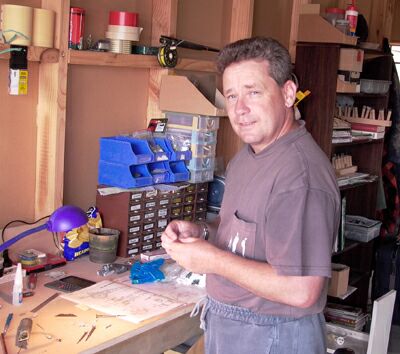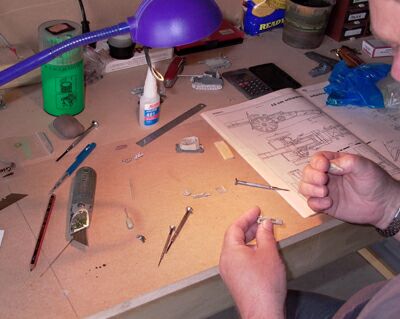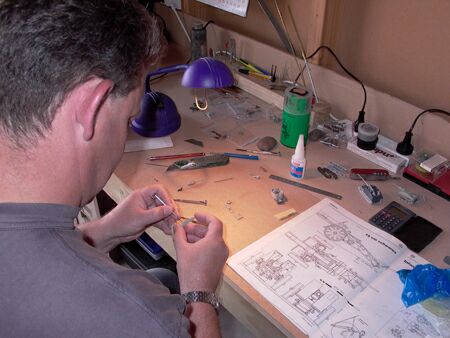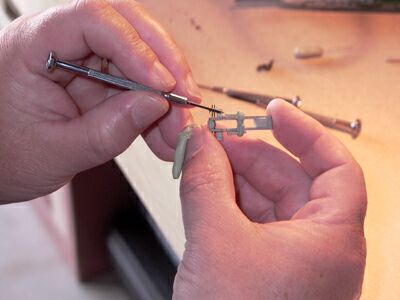|
|
|
|
Products mentioned in this Article
--None--
|
|
|
|
|
|
|
|
|
 |
|
|
 |
Interview with a Master Modeller
We look at our sculpting department, introduce you to our chief sculptor Evan Allen and look in to the evolution of our miniature range.
By Richard Carisle, Photographs by Simon Patton
This issue we are going to look at our sculpting department, introduce you to our chief sculptor Evan Allen and look in to the evolution of our miniature range.
Evan Allen was born and raised in New Zealand. After 22 years in the military he now sculpts full time for Battlefront. Having made the majority of the range, he is now working on his 3rd generation of miniatures.
|
|
Evan, tell us how it all started?
I started modelling when I started walking, mainly with Plasticene (no play-dough back then!) and only progressed to gaming when my Dad bought me some Airfix plastic soldiers one fateful Christmas. I hated putting together plastic kit sets so I always tried to make my own stuff, to play games with the soldiers I had. Then one day I was to old for my parents to support me anymore so I joined the Royal New Zealand Air Force instead of getting a real job and had twenty two years of doing things others only dream about, flying in jets, parachuting, being paid to get drunk in foreign countries.... the list is endless! But eventually the desire to make tanks and aeroplanes in miniature became too hard to resist (and my wife wanted me to stay home more)…
Many people are amazed at how someone can make such detailed miniatures, can you take us through the process of developing these?
To begin the process the team at Battlefront will sit down and review the current range. Models need replacing/renewing sometimes because of a worn out mould or inaccuracies on the original ’master’ model.
|
 |
 |
The decision on what new models are to be made depends on what army list our rules writer is currently working on.
How do you decide its time to re-make a perfectly good model?
As I gain in experience and master new techniques I constantly compare my latest work to older models. If I find an older one that really annoys me by containing inaccuracies or is not as well detailed or shaped then it immediately goes on my "mental list" to remake it when our schedule permits. Sometimes though, a customer will point out a defect and then if it’s serious (like embarrassing!) enough it will go on the BF priority list to be fixed ASAP.
|
|
So you’re now armed with your list and deadlines, what happens now?
Research. I search out all the reference material I need, before I actually start mixin’ puttys’. If it’s a vehicle then the first priority is scaled line drawings followed by as many photos (even modelling magazines help out here) as I can get to ensure accurate details and a lifelike appearance. Also this is the time to decide how a model will go together, which is important for both the production team and the gamers who buy them.
For sculpting figures I like to work off
photographs of the real thing and again you can never have enough
reference material to work with. All the figures that are needed to
make a range complete are worked out here.
|
 |
 |
Once the research is done
its time to mix putty! (Bend wire, sharpen pencils clean ruler…)
What do you aim for in level of detail?
The finished model or figure should be easily identifiable to the most inexperienced gamer and the most experienced gamers should be pointing out where I’ve put too few rivets or, maybe, the wrong shaped rivets! Seriously though, if gamers point out the smallest detail that’s incorrect it means they are having to look pretty damned hard to find them!
What hinders you from re-producing the exact details found on the real thing?
The scale of the models means you have to take some liberties to accommodate production needs, like barrels or aerials being slightly thicker than scale size.
|
|
And some detail is simplified (as little as possible) to reduce the
amount of assembly required. Longevity on the tabletop battlefield is
important as well so I try to design them to be as robust as possible
but still look the part.
Are you ever fully satisfied with your results?
I find that if I have a powerful urge to paint what I’m working on then I’ve got it the best I can do... but you can guarantee that in 12 months time something will bug me!
Thanks Evan, and if you want to find out more about sculpting miniatures, we’ll be checking out Evans workshop at a future date.
|
 |
Last Updated On Friday, May 16, 2008 by Wayne at Battlefront
|
|
|